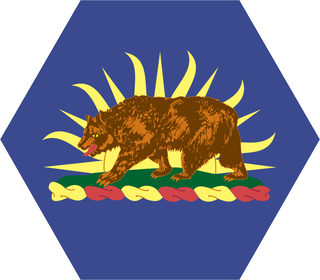The 200th Coast Artillery (AA) (200 CA) was a United States Army unit during the first half of World War II. Today descendant elements serve with the New Mexico Army National Guard as the 200th Infantry.
The British Army is listed according to an order of precedence for the purposes of parading. This is the order in which the various corps of the army parade, from right to left, with the unit at the extreme right being highest. Under ordinary circumstances, the Household Cavalry parades at the extreme right of the line. Militia and Army Reserve units take precedence after Regular units with the exception of The Honourable Artillery Company and The Royal Monmouthshire Royal Engineers.

The Bolivian Army is the land force branch of the Armed Forces of Bolivia. Figures on the size and composition of the Bolivian army vary considerably, with little official data available. It is estimated that the army has between 26,000 and 60,000 men.

The Florida Army National Guard is Florida's component of the United States Army and the United States National Guard. In the United States, the Army National Guard comprises approximately one half of the federal army's available combat forces and approximately one third of its support organization. Federal coordination of various state National Guard units are maintained through the National Guard Bureau. The Florida Army National Guard was composed of approximately 10,000 soldiers. The main state training grounds is Camp Blanding.
The following units of the German First Army and British Expeditionary Force fought in the Battle of Mons in World War I.
This is a list of Confederate government Civil War military units, not raised by any state.

The California Army National Guard is one of three components of the California National Guard, a reserve of the United States Army, and part of the National Guard of the United States. The California Army National Guard is composed of 18,450 soldiers. Nationwide, the Army National Guard comprises approximately one half of the US Army's available combat forces and approximately one third of its support organization. National coordination of various state National Guard units are maintained through the National Guard Bureau.

In the United States (US) military, a beret flash is a shield-shaped embroidered cloth that is typically 2.25 in (5.72 cm) tall and 1.875 in (4.76 cm) wide with a semi–circular base that is attached to a stiffener backing of a military beret. These flashes—a British English word for a colorful cloth patch attached to military headgear—are worn over the left eye with the excess cloth of the beret shaped, folded, and pulled over the right ear giving it a distinctive appearance.

The British Expeditionary Force order of battle 1914, as originally despatched to France in August and September 1914, at the beginning of World War I. The British Army prior to World War I traced its origins to the increasing demands of imperial expansion together with inefficiencies highlighted during the Crimean War, which led to the Cardwell and Childers Reforms of the late 19th century. These gave the British Army its modern shape, and defined its regimental system. The Haldane Reforms of 1907 formally created an Expeditionary force and the Territorial Force.












